Looking to shed fat or gain muscle? Start by eating right for your goals. Get the lowdown on the key nutrients everyone needs in this macros 101 guide.
Over the past 2 years, I’ve been following the Faster Way Program with great results, completely transforming my body and fitness.
Whenever I share my journey, I get many questions about macros. Today, I’ll answer all your questions and give you a peek into what a day of eating looks like for me.
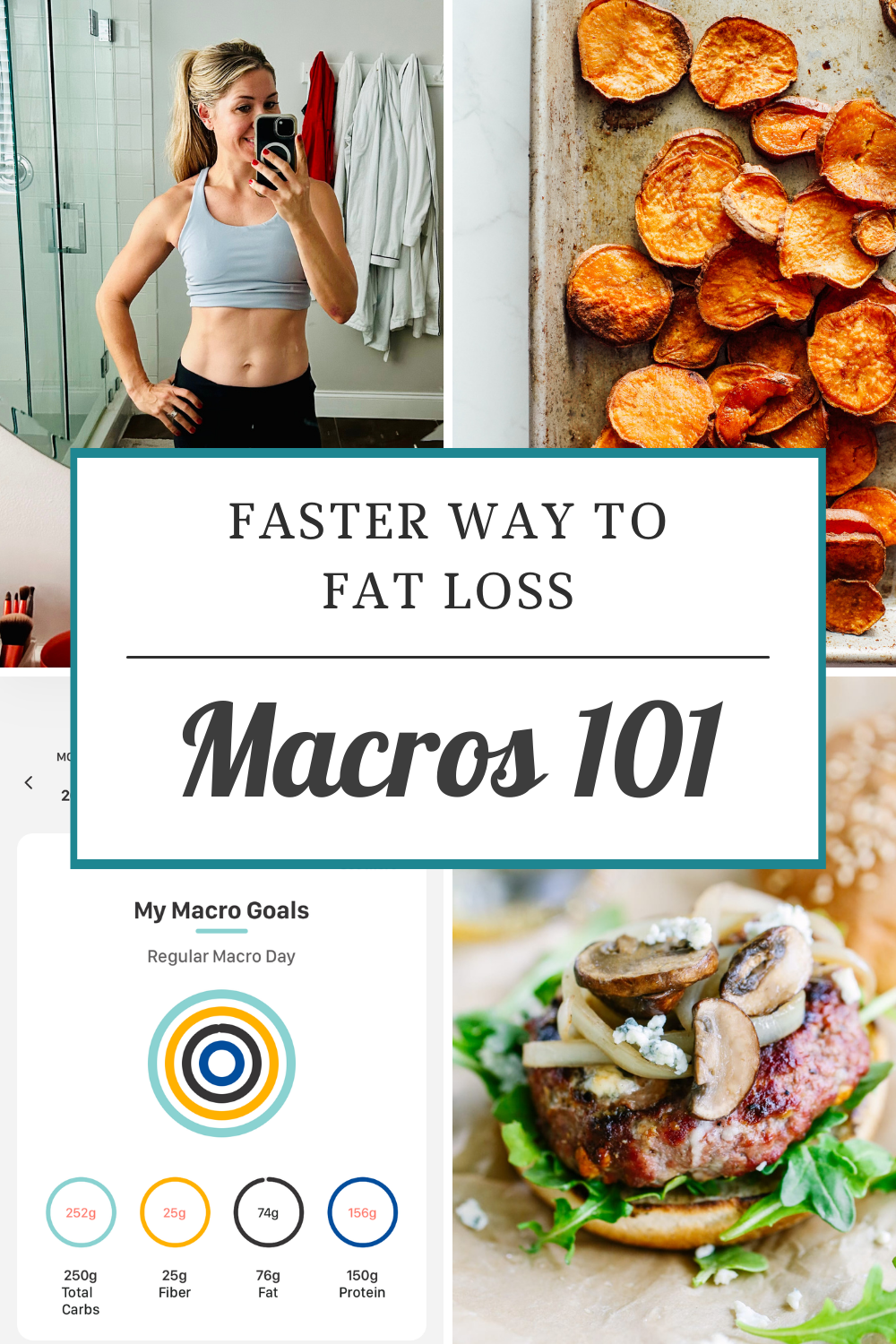
Want to Save This Article?
Enter your email & I’ll send it straight to your inbox. And you’ll get new recipes & tips each week.
I recently shared my fat loss journey, including 2 years’ progress photos. Before Faster Way, I lived a healthy lifestyle and ate healthy, real food, but I couldn’t figure out why I was gaining weight in my late 30’s.
But that changed as I learned to track macros and lift heavy weights via this great program.
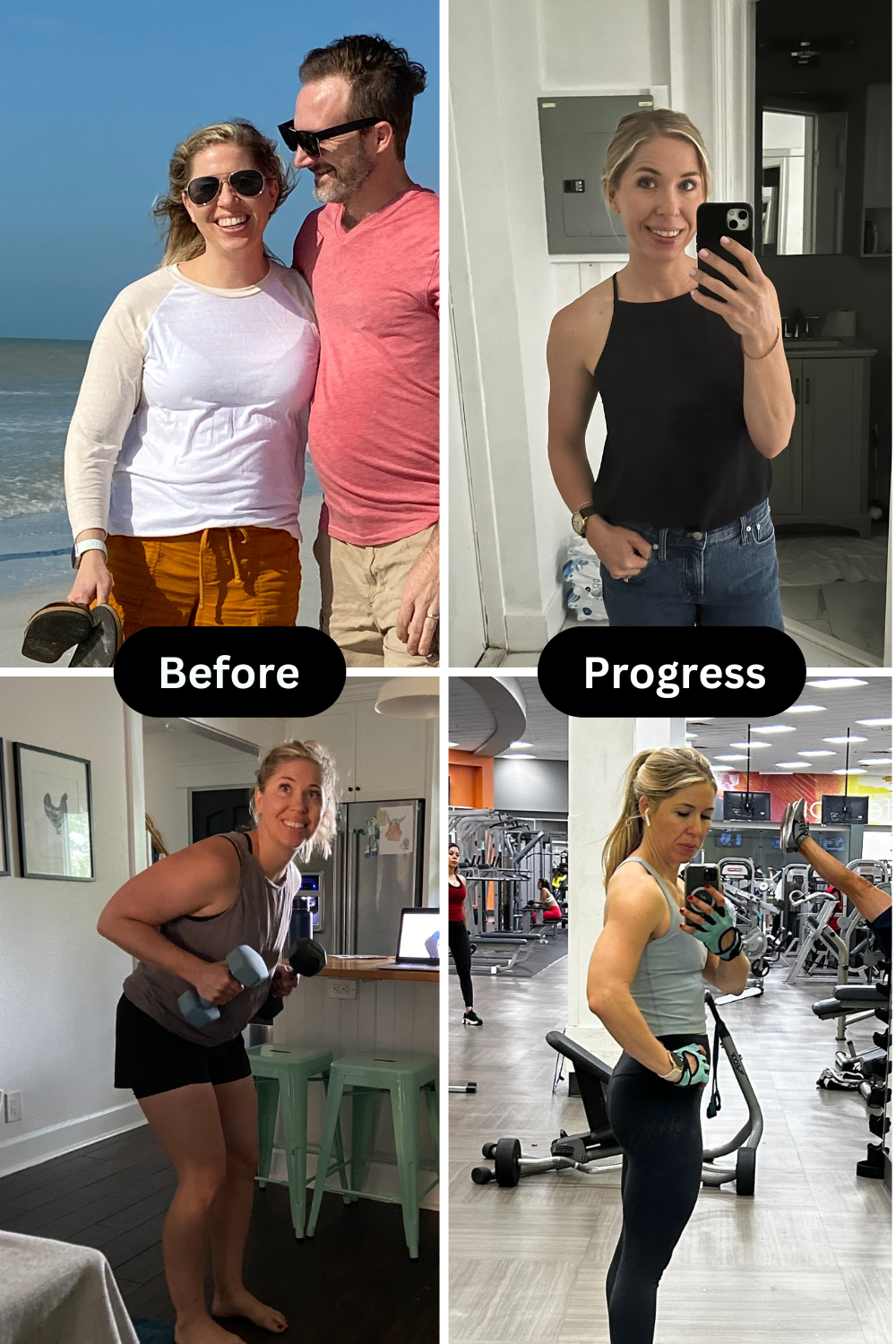
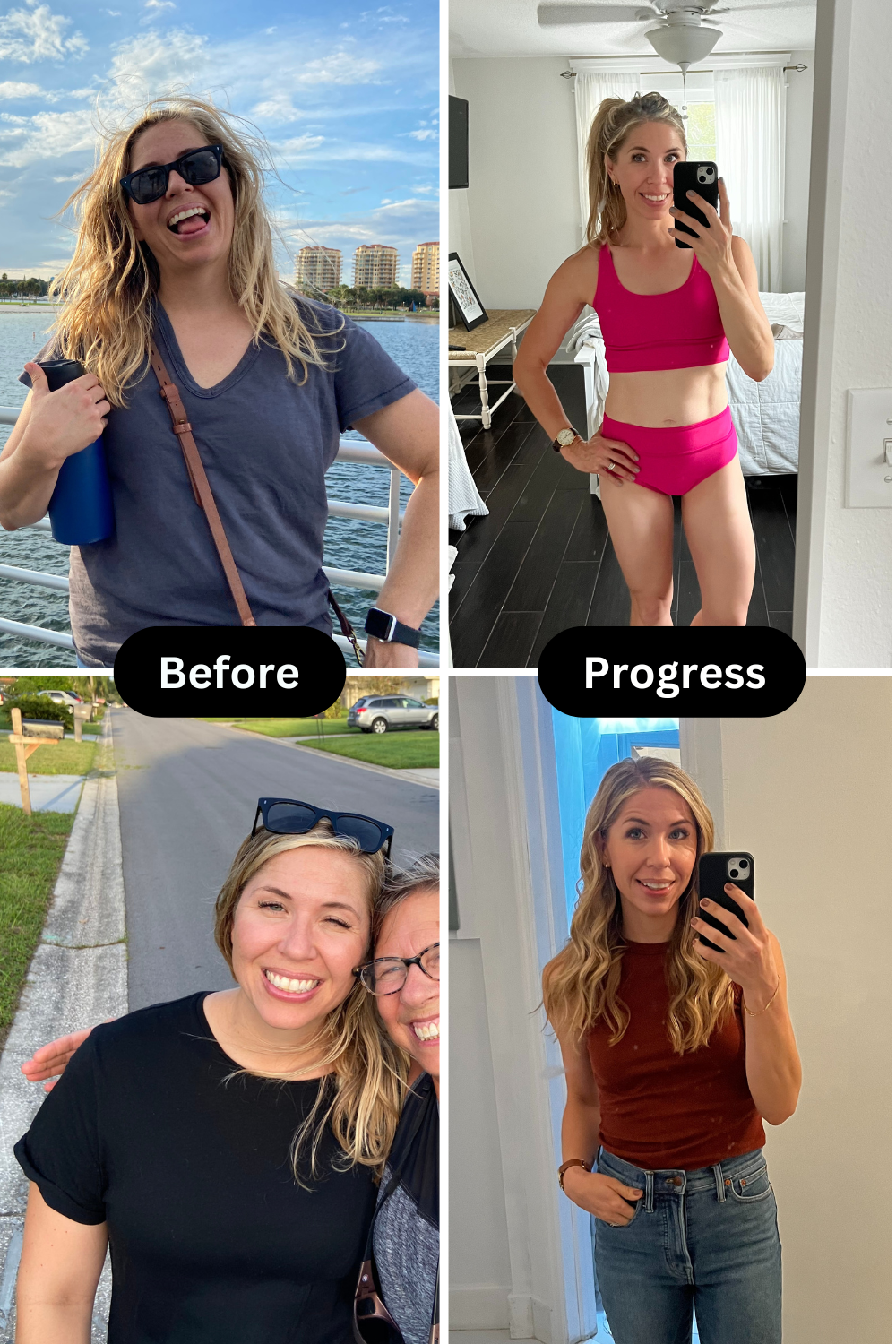
What is Faster Way to Fat Loss?
Faster Way is a digital fitness and nutrition program that teaches clients how to burn fat and build muscle through 2 key components:
- Nutrition – Customized macro counting and calories that align with your specific goals.
- Strategic Workouts – A focus on building muscle through strength training, either at home or in the gym. Learn more about the Faster Way workouts here.
It’s through Faster Way that I learned how to track macros and have received custom macros from my coach (and adjustments based on my goals over the last 2 years), and how to lift weights. Before Faster Way, I knew nothing about macros or strength training. So I have to give credit where credit is due. Thank you, Faster Way and my amazing coach, Sandi!
How Do I sign Up?
Join a 6-week round with my incredible Faster Way Coach, Sandi.
What is a Macro?
The word “macro” is short for macronutrient. Macros break down into 3 main categories:
- proteins
- carbs
- fats
According to the Faster Way Beginner’s Guide to Macronutrients, “Macronutrients are the molecules our bodies need to function. We use these molecules as energy to work on cellular, tissue, organ, and organismal levels. This energy helps us break down nutrients, repair damaged cells, grow new cells, and more. Everything you eat falls into macronutrient categories, so your body is actually tracking macros already.”
For optimal health, your body needs a ratio of each macronutrient. This is why you shouldn’t eliminate any one macro from your diet (this is also why diets like low-carb and keto are not sustainable in the long run and lead to poor health issues).
Each macronutrient plays a crucial role in maintaining a healthy, happy body.
The 3 Macronutrients: Protein, Carbs, and Fats
Let’s take a look at each macronutrient and the important role it plays. Also, download the free Faster Way macro cheat sheet guide here.
Proteins
- Protein is the building blocks of muscle.
- The only way to build and maintain muscle mass is to eat enough protein and lift heavy weights.
- Many people under consume an adequate amount of protein for their body, which is easy to do if you’ve never tracked your protein intake.
- If you don’t eat enough protein, you’ll lose muscle mass, which means your metabolism will slow, and you’ll have difficulty losing fat and building/maintaining a strong body. Your metabolism has little to do with your age.
- We lose muscle mass as we age, so it’s essential to focus on protein and lifting heavy weights to build and maintain lean muscle, keep your metabolism strong, and maintain healthy body weight.
- Protein Examples – Chicken, greek yogurt, fish, beef, eggs (mainly the whites as the yolk is mostly fat), protein powder, beans, and tofu.

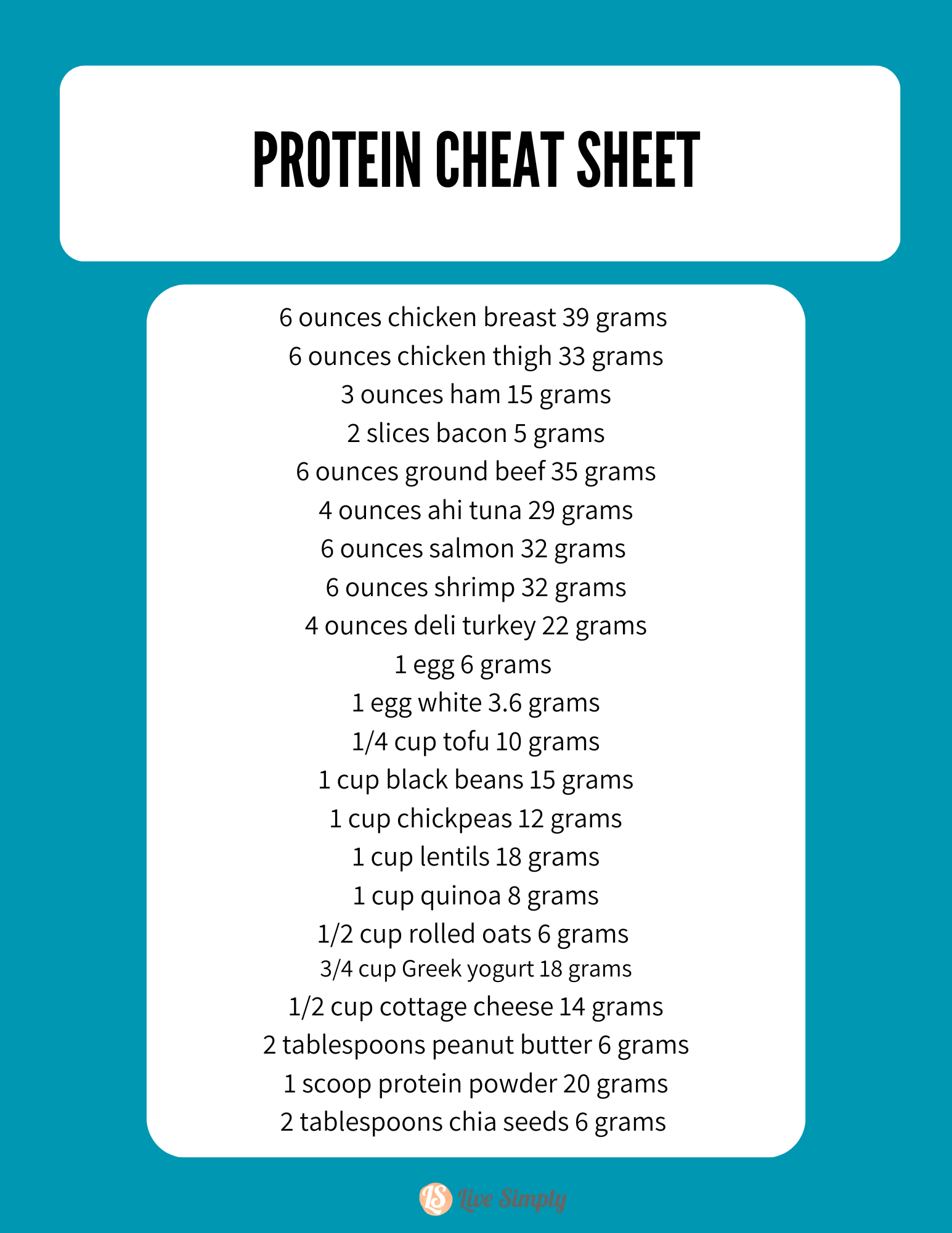
Fats
- The most calorically dense macro.
- Fat doesn’t make you fat, but many people naturally over-consume this macro without realizing it (it’s easy to do), leading to a calorie surplus. A calorie surplus is the only way to gain fat.
- Fats are vital and help to support your metabolism, cell signaling, immunity, and hormone production.
- Fat Examples – Nuts, butter, cheese, sour cream, peanut butter, seeds, avocado, salmon, olives, bacon, and olive oil.
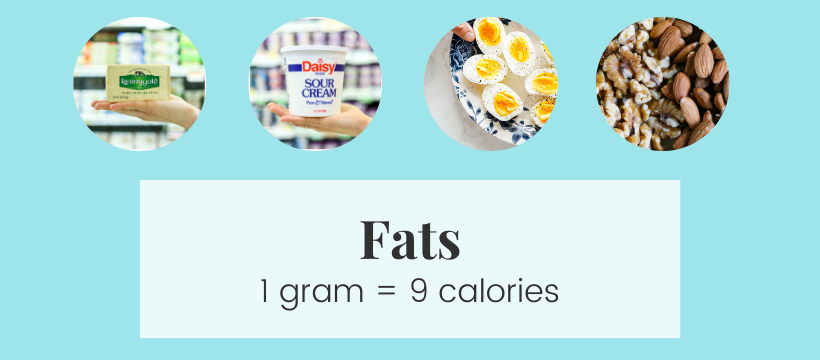
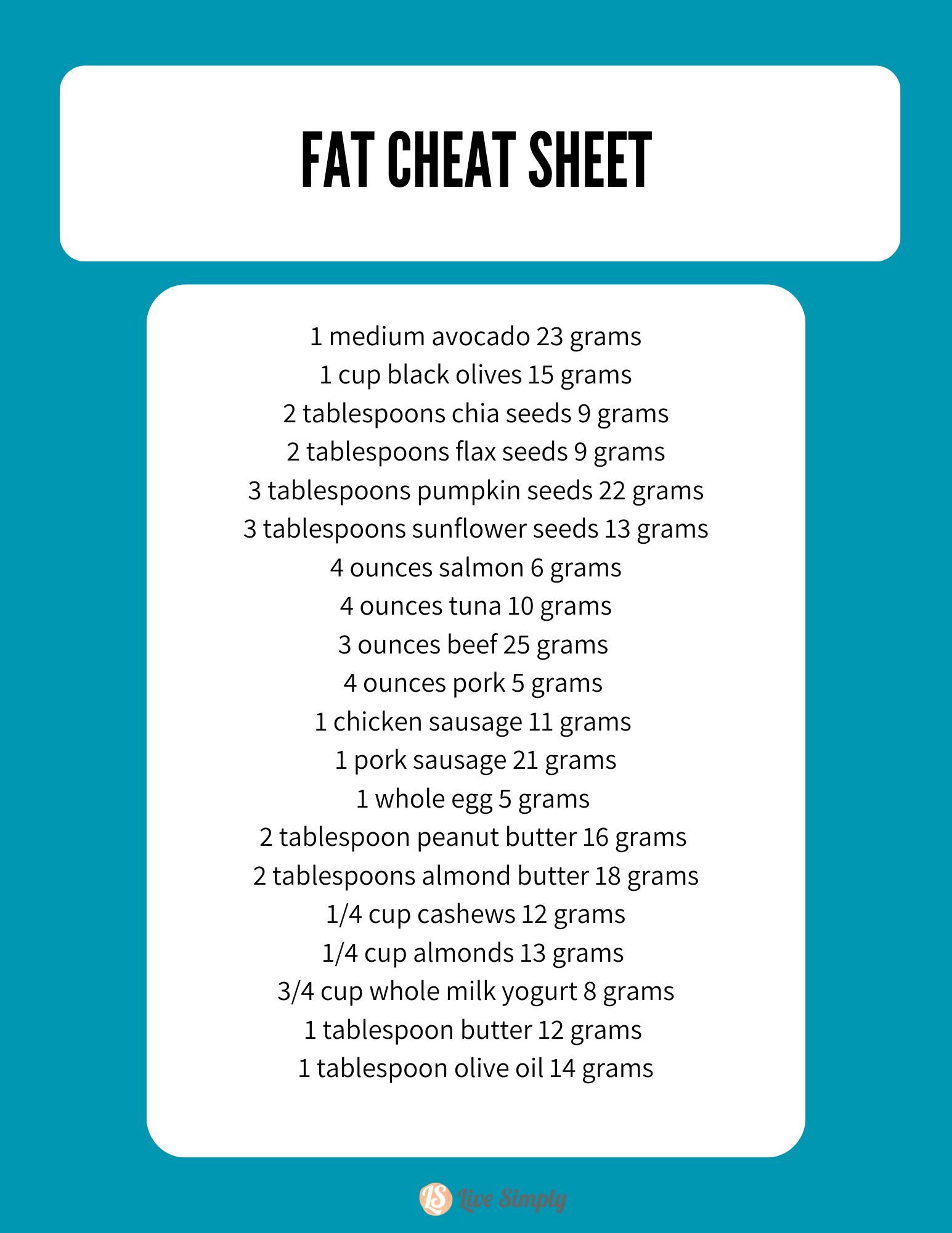
Carbohydrates
- The body’s primary fuel source.
- Carbs do not make you fat. Carbs do contain water (carbo-hydrate). When you eliminate them from your body, you may notice a small decrease in weight on the scale (this is water weight; not fat). This change has nothing do with body composition changes or fat loss.
- Most complex carbs (whole grains, berries, fruit, oats, potatoes, etc.) contain a great amount of fiber, and getting at least 25 grams of fiber in your diet daily is important for overall health and feeling satisfied between meals. Most people under-consume fiber-rich foods.
- If you’re not consuming enough carbs, you may notice frequent energy slumps, constipation, intense cravings, difficulty concentrating, thyroid issues, and adrenal issues (source).
- Carb Examples – Sweet potato, white potato, vegetables, brown rice, white rice, bread, oats, berries, apples, and bananas.
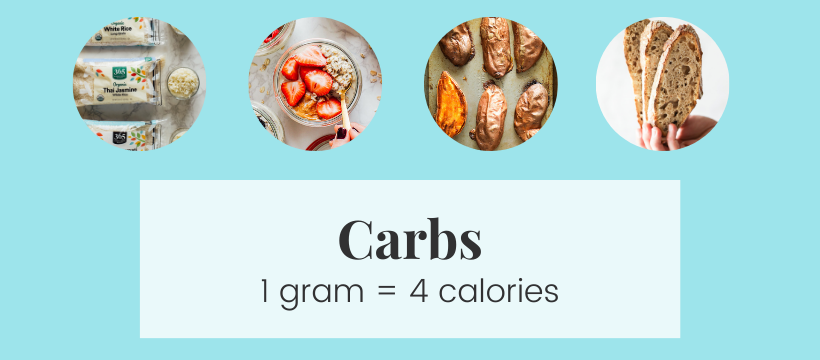
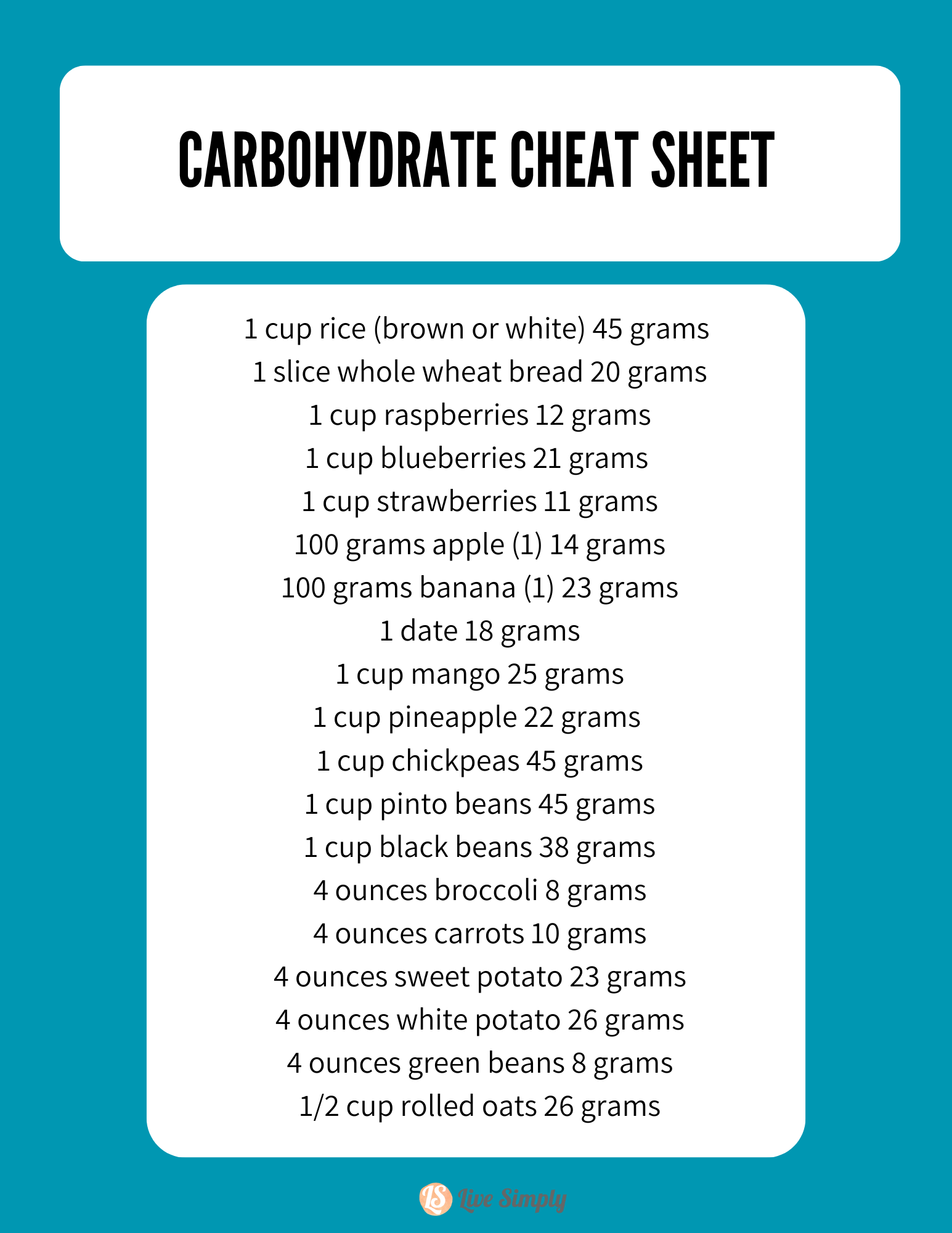
Calories and Macronutrients: A Winning Combo
Each macro corresponds to a calorie amount per gram.
- Proteins = 4 grams of carbs
- Fats = 9 grams of carbs
- Carbs = 4 grams of carbs
When you add these up, say your macro breakdown is 130 grams of protein x 4, 200 carbs of carbs x 4, 67 grams of fat x 9, you get your calorie target number.
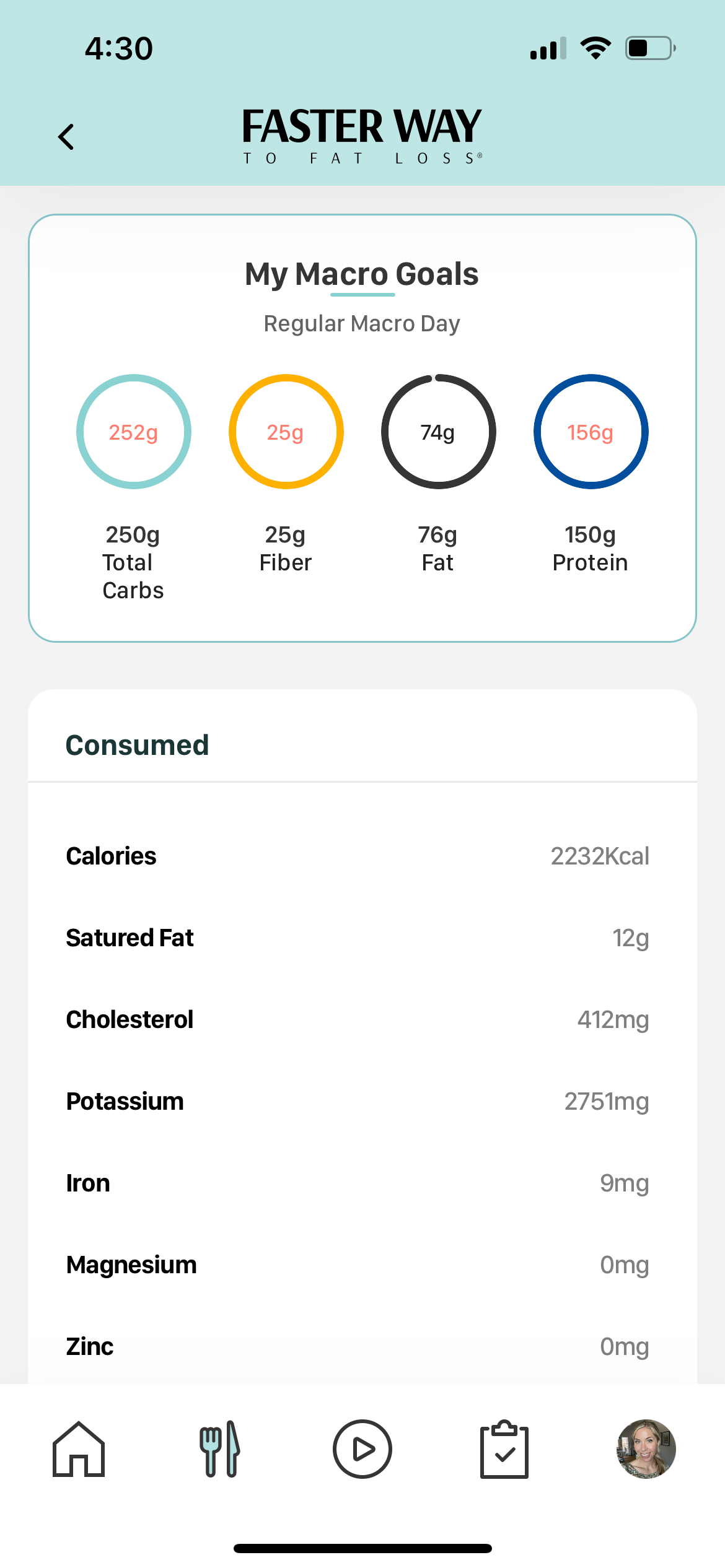
- Diet Programs & Calories – All diet programs focus on calories, which is why most diet programs work (for the short term). But most programs put people in such an extreme, one-size-fits-all calorie deficit that the results and lifestyle are not sustainable in the long run.
- Calorie Quality Matters – While concentrating on calories is okay, and will help you lose weight, calories alone don’t address the quality of food you’re eating.
- Macros Are Important – Each macronutrient is critical in maintaining a healthy body. So, focusing on calories (the ultimate determiner of fat loss) and where those calories come from is essential. This is particularly important with protein, as you don’t want to lose muscle during a fat loss phase (which happens in most weight loss programs and is why these programs wreak havoc on a metabolism).
Why Track Macros?
- Awareness – Tracking brings attention to what you’re eating, how much, and what a proper amount of food in each macro group looks like for your body and to achieve your goals. Without tracking, most people have no idea how much protein they consume daily. Getting adequate protein is critical to building and maintaining muscle mass, particularly as we age.
- Reach Your Goals – Macro tracking is an amazing tool that you can tweak and play with based on your goals. By tracking macronutrients, you’ll focus on getting a specific amount of each macro to achieve your goals (fat loss, building muscle, maintaining, etc.). No longer does one feel confused and helpless about how to reach these goals.
- Food Freedom – It’s hard to explain, but tracking my macros has given me so much education and knowledge on how to eat and that has brought about incredible food freedom. I no longer fear food, food groups, treats, dinners out, vacations, etc. If I want cookies, I can eat the cookie. If I want to smash burgers, I can enjoy a smash burger. Fries? Yep, that’s cool, too. I can make all these foods and more part of my life without fear or guilt. And because of that, along with being nourished with a balance of each macro group daily, I no longer have intense cravings because “I can’t have that.” I understand how fat loss, muscle building (which requires food!), and weight gain work, and I know that no foods are bad. Sure, there are more nutritionally-dense foods, but morally, I don’t look at any food in a good or bad way. I also have an excellent understanding of how much food my body needs and what that looks like. Since I’ve focused on building muscle over the last two years through lifting heavy weights and eating, I know that when I do over-consume the number of calories it needs to maintain during a vacation, holiday, date night, etc., my body can metabolically handle this surplus. Tracking macros has allowed me to live a more balanced lifestyle and know when to enjoy food and cherish food memories without guilt. It has eliminated constant cravings (because nothing is off limits, and I’m also eating enough of all food macronutrients to satisfy hunger), giving me an even better relationship with food.
How Many Macros Should I Eat?
How many macros you eat is specific to you, your body, and your current goals. My daily macros will be different than yours, and yours will be different than mine. Macros are not a “one size fits all” thing. Here are a few ways you can breakdown your overall calorie consumption into macros.
- 45/25/30 Breakdown- Generally speaking, most Faster Way clients (the ladies, at least, I can’t talk to the men’s program nutrition) use a macro breakdown of 45% carbs, 25% protein, and 30% fats. This means that 45% of your calories will come from carbs, 25% from proteins, and 30% from fats. This is the most common breakdown for fat loss and muscle growth.
- Other Macro Breakdowns – Other options include, 50% carbs, 20% protein, and 30% fat or 40% carbs, 30% protein, and 30% fat.
- Coach Adjustments – When you join Faster Way, you don’t have to think about this as your coach will create your custom macros and percentage breakdown based on your unique body and current goal.
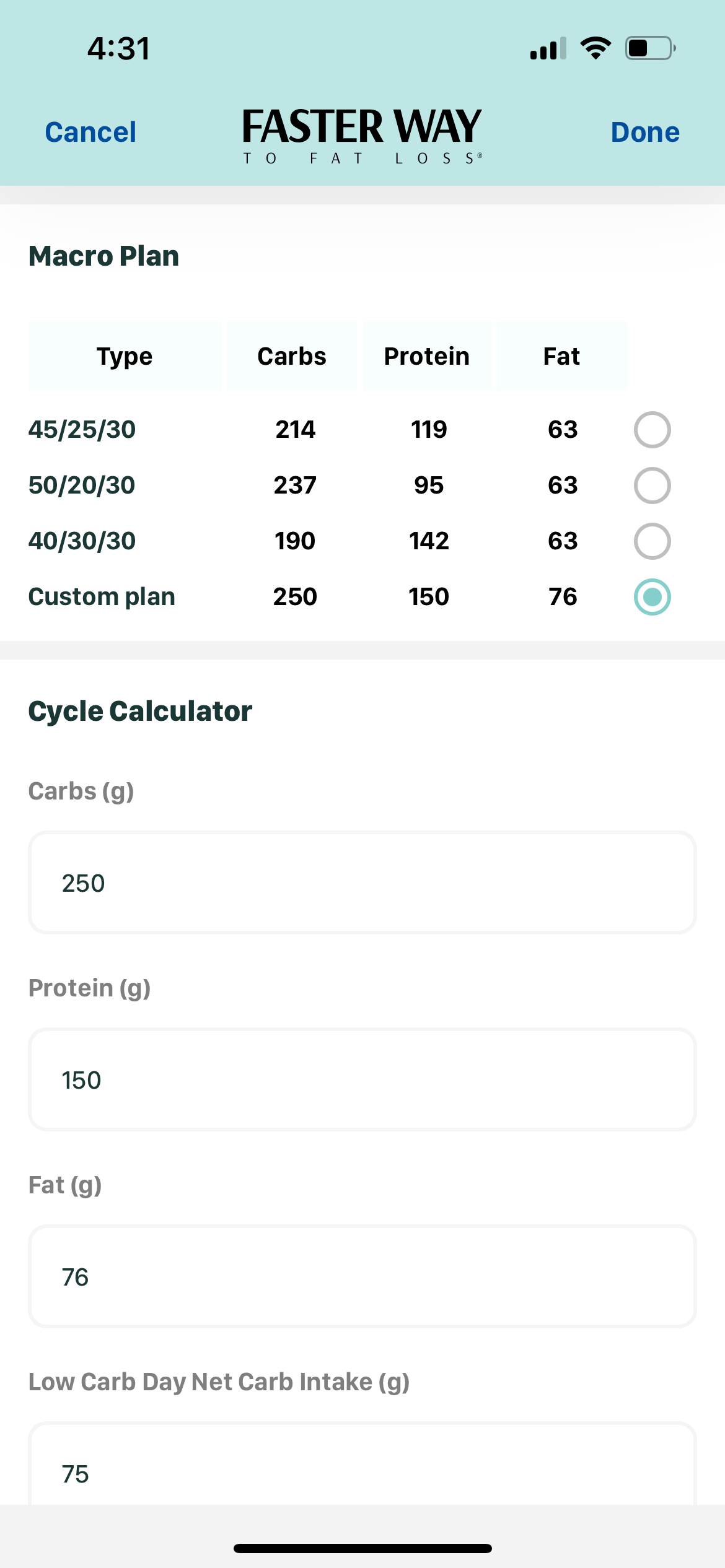
How Do I Determine My Unique Macros?
There are 2 ways to determine your specific macros. Remember, macros are unique to each person as we are all different.
- Certified Coach – The best way is to start by working with a coach who can set up your macros, monitor your progress, and adjust as needed. When joining Faster Way, you must start with a 6-week round. During this 6 week time, you’re paired with a certified FWTFL coach who will calculate your custom macros based on your body, weight, activity levels, past dieting history, goals, etc. These are your initial macro goals/targets based on your current body and fitness goal (whether it’s fat loss, maintenance, etc.). These macros will and should change as your body changes and you build more muscle, lose fat, etc. The beauty of having a coach (who continues with you if you choose to continue into the month-to-month VIP option with Faster Way) is your coach will work with you to adjust those macros and offer the additional support to reach your goals. My macros changed multiple times over the past 2 years as I built more muscle (which requires more food to maintain and increased my metabolism) and transitioned from a fat loss to a maintenance goal.
- Macro Calculator – Another option is to use a macro calculator (Google “macro calculator,” and you’ll find many options). The calculator will ask you questions like your height, weight, activity level, and goal (fat loss, maintenance, which means you want to maintain your current weight, etc.). After an initial survey, the calculator will provide you with an idea of what your estimated macros are based on your goal/body at the moment. Keep in mind that calculators are not personal like a coach who can adjust numbers based on how your body responds to these initial numbers, so use these calculators as more of an estimate than an exact number. For example, macro calculators estimate my maintenance calories to be about 1850/1900. However, in working with my coach, we found that my true maintenance calories are 2300. That’s a big difference.
How Do I sign Up?
Join a 6-week round with my incredible Faster Way Coach, Sandi.
How Do You Track Macros?
- Meet Your Macro Goals Through Tracking – Once you know your macro targets (specific macro grams that you should aim to eat each day), it’s time to start tracking what you consume to ensure you hit these macro goals.
- You Must Track If You’re Working Toward a Goal – This is the ONLY way you will see progress if you have a specific goal like fat loss, building muscle, or working to maintain your weight. You have to track for some time. You don’t have to track for the rest of your life.
- Use a Macro Calculator – The easiest and best way to track macros is to use a macro calculator. A macro calculator will do all the work for you; all you have to do is enter the food you’re consuming (most tracking apps have large databases with thousands of different foods), and the calculator will do the rest.
Here are a few options for macro trackers
- Faster Way App – Available to all Faster Way clients, which includes an exclusive macro calculator, macro tracker (I love how visual the tracker is, see below image), a recipe library (whole food recipes), and meal plans (if you want ideas each week for well-balanced meals that will help you meet your macro goals). This option also comes with a coach to set up your custom macros, education how to track and meet your macro goals, and their support.
- My Fitness Pal – I’ve never used this popular calculator and tracker, but many people love it. My Fitness Pal was free, but now it’s a paid macro tracker.
- Cronometer – I know a few people who love this macro tracking app. There is a free and paid version. If you’re serious about tracking, the paid option is best.
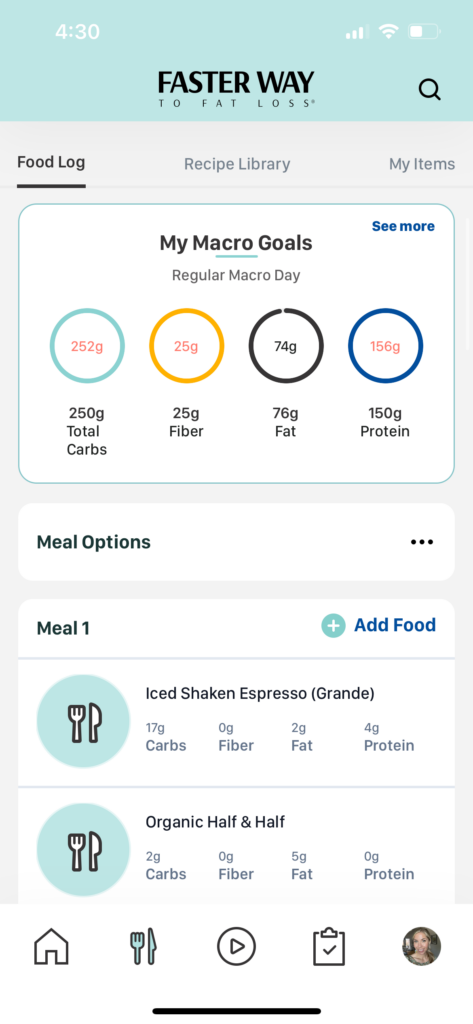
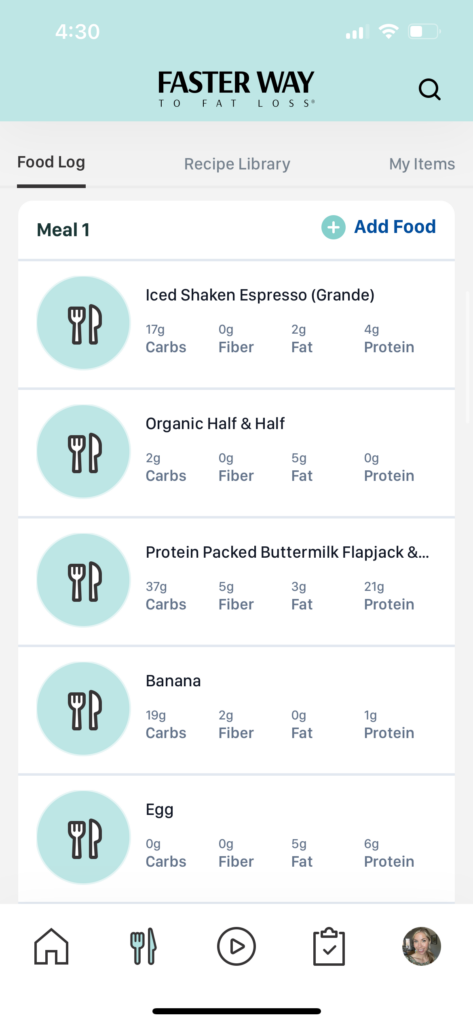
Fat Loss, Maintenance, and Bulking: When & How to Change Your Macros
Your current macros aren’t a forever thing. They will and should change based on your body, metabolism, hunger cues, and goals.
Here are the 3 phases you may find yourself in over the years, as you progress in your fitness journey, during which your macros will look different.
- Fat Loss – Macros/calories set to a slight calorie deficit are needed if you want to lose fat. A calorie deficit is the ONLY way to lose fat. It’s important for you to eat enough calories (and protein macros in particular) to maintain muscle mass during this time. During this time, you’ll be tracking data via progress photos and measurements. Your macros may need to be adjusted based on how your body responds (using data to guide adjustment decisions- this is where a coach is super valuable). A general fat loss phase is around 12 weeks.
- Maintenance – You can’t stay in a fat loss phase forever as you don’t want your metabolism to adapt to these low numbers (and it’s not fun), so eventually, you must reverse your macro targets and calories up. This will take increasing your macros to where your body can maintain your current weight while slowly building muscle. This is where your body is happiest! For me, this meant working with my coach to increase my macros 5% every few weeks based on my hunger cues, strength, and other biofeedback markers (like sleep). Usually, significant fat loss and a toned look are achieved through years of maintenance and then short fat-loss phases. This is the healthiest, most sustainable way to lose fat, build a toned body, and support your metabolism. But this method certainly isn’t as sexy as quick-fix diet programs. You can also stay in maintenance for years, or the rest of your life. No need to go back to a fat loss stage (or bulk) if it’s not needed or desired.
- Bulk – Building muscle in maintenance is a very SLOW process that takes years, so some folks purposely eat more macros/calories than their body needs for a short time and go through a “bulk” phase. Building muscle requires lots of food, so you can put muscle on your body much faster by eating slightly more than the body needs and lifting heavy weights. During a bulk, you’ll also put on some fat and muscle. So usually, people will complete a bulk phase and go into a fat loss phase (to maintain muscle but lose fat) and then work up to maintenance. I’ve never done a bulk, and I don’t plan to (not yet, at least). Going through a bulk would also mean a change in macros/calories.
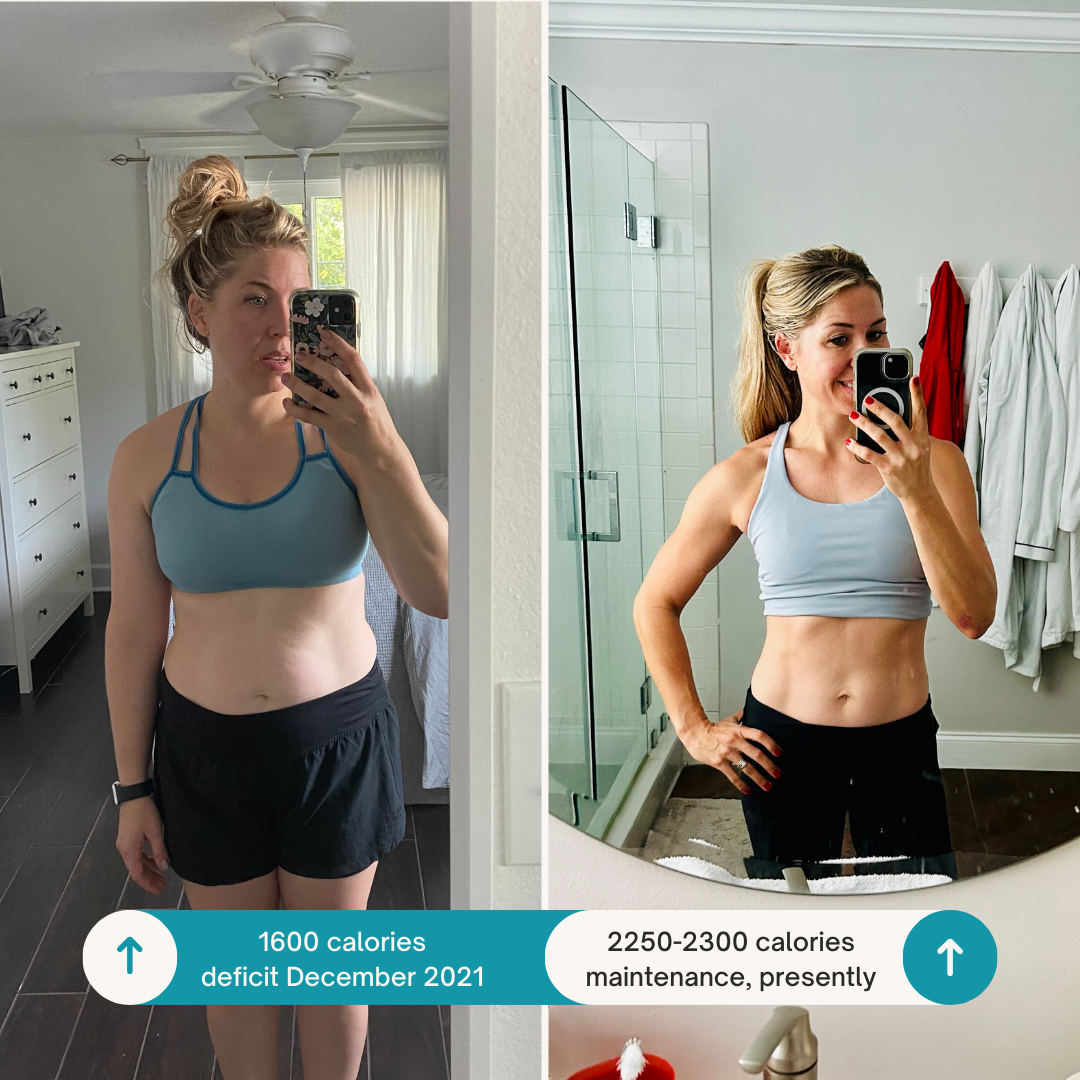
Having my Faster Way coach has been an invaluable resource in helping me navigate changing macro needs over the last 2 years on my incredible journey.
As I mentioned in my 2-year journey post, the coach will make or break your experience with Faster Way, and Sandi is incredible at able providing custom macros and guidance (not all coaches do).
What I Eat in a Day: Example of Macro Tracking & Meals
I share my daily meals on Instagram. Here’s an example of what I eat in a day.
This meal plan example is based on my current macro goals (in maintenance) of 142 grams protein, 76 grams fat, 245 grams carbs, and 25 grams fiber.
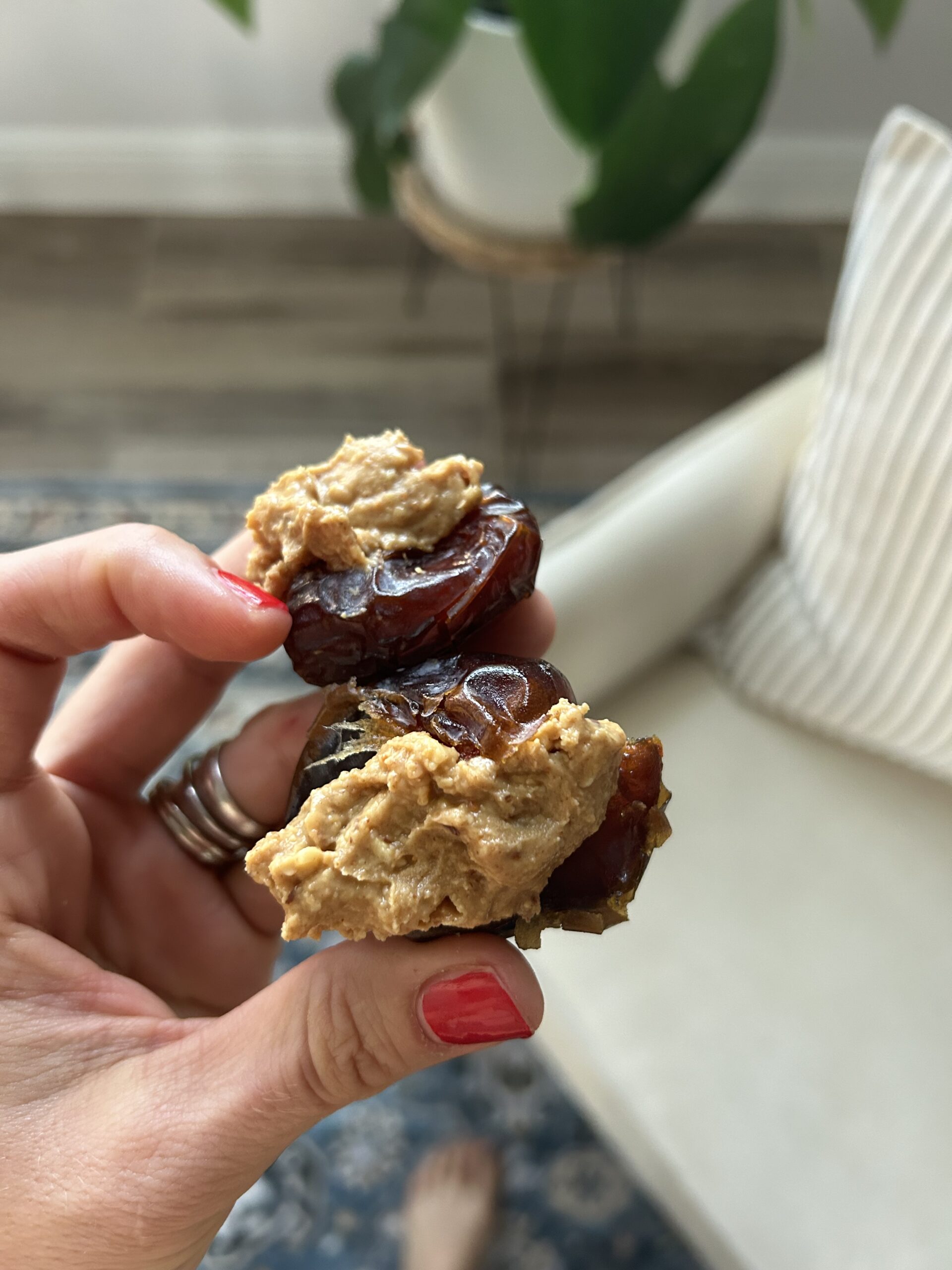

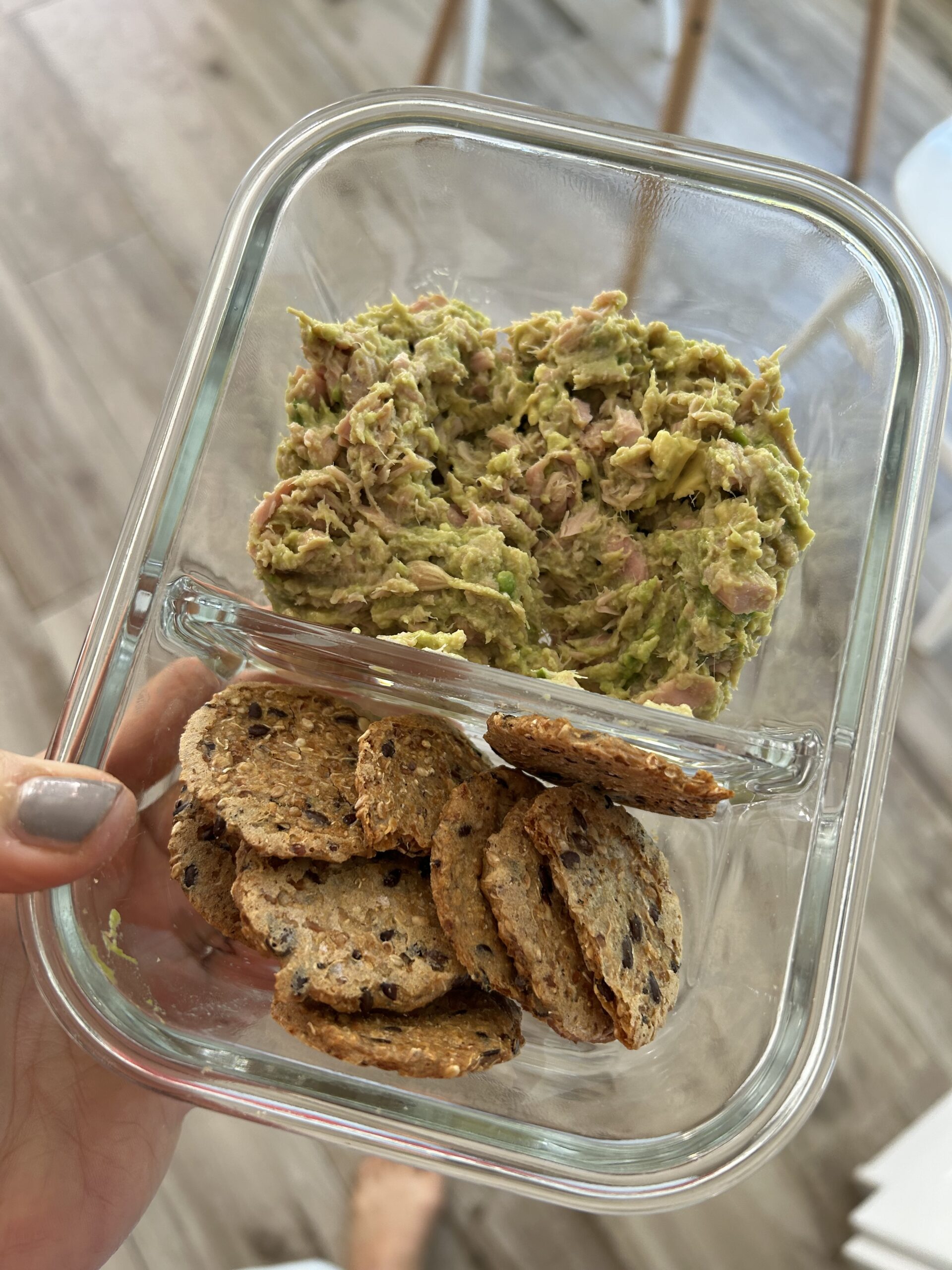
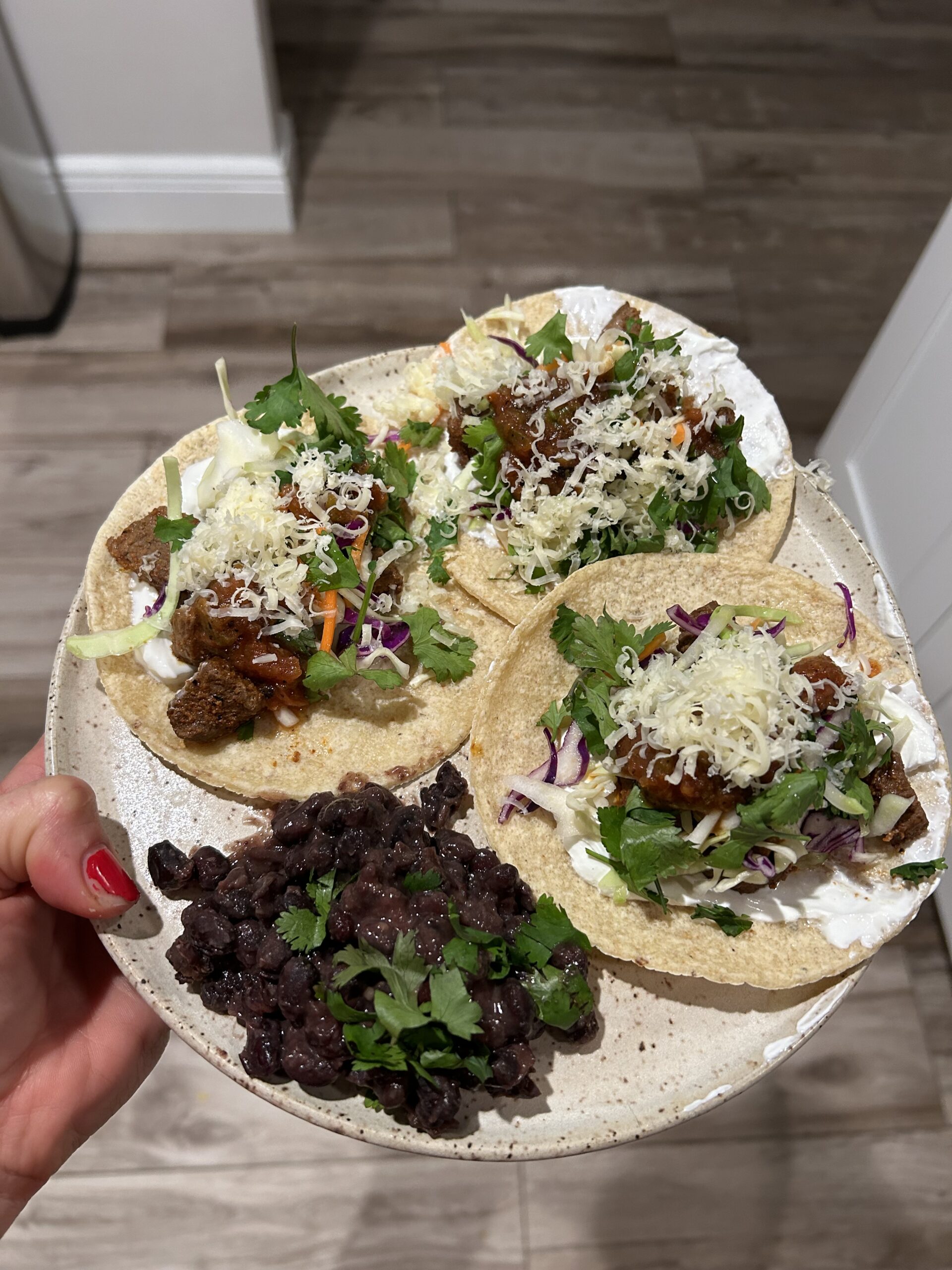
- Break My Fast & Pre Workout – Coffee with heavy cream, water and electrolytes, and creatine, 2 dates with peanut butter (I like to eat carbs before training; carbs are the body’s preferred energy source and help me get through a workout)
- Breakfast – 1 egg + 3 egg whites (for extra protein) omelet with ham, 2 slices of cinnamon raisin toast with cream cheese, berries + Greek yogurt with honey
- Lunch – Tuna mashed with avocado (a great way to get in fat and fiber) and salt, crackers, apples, cucumbers and carrots
- Snack – Smoothie with rolled oats, peanut butter powder, protein powder, banana, almond milk, ice
- Dinner – Ground beef tacos (corn tortillas, ground beef), avocado, cheese, sour cream, slaw and black beans on the side. If I’m still hungry after dinner or need to catch up protein, may have some Greek yogurt.
- Begin my Overnight Intermittent Fast – Usually about 12 hours, sundown to sun up, but I’m not super strict on this.
Reader FAQs
How can you be hungry for this much food? It seems like a lot!
When I started my journey, my metabolism was “in the trash” and I honestly didn’t have much of an appetite. I soon learned that this “lack of appetite” isn’t a good/healthy metabolic sign. I could go all morning without any hunger cues.
As I built muscle, my metabolism began to “fire up” and suddenly I was hungry like never before. I woke up wanting food with hunger signals -a sign of good metabolic health. Muscle mass is key to maintaining a healthy metabolism and to do that you must lift heavy weights and eat enough protein!
At first, the amount you need to eat may seem like a lot, trust the process, focus on lifting heavy weights 3 times a week and eating your macros. You’ll soon find that your desire for more food picks up as your metabolism fires up.
I tried tracking calories in the past and it didn’t work.
Most diet programs put people in such a low-calorie deficit (eating fewer calories than you need) that a person loses weight rapidly, losing both fat and muscle mass. And muscle mass is the key to a healthy, thriving metabolism. This causes the metabolism to adapt to a super low-calorie intake and slow. When a person eventually goes back to eating more calories (because such a low-calorie target isn’t sustainable in the long run), they regain all the weight and more.
For example, people on Optavia eat around 800-1000 a DAY!!! That’s a recipe for disaster and a sure way to lose muscle (and a ton of scale weight), down-regulate your metabolism, and eventually gain back a ton of weight when you start eating normally again.
Faster Way, on the other hand, uses a calorie and macro approach, with a slight caloric deficit (eating less than your specific body needs to maintain) and an emphasis on the quality of those calories to maintain muscle mass (and even build more muscle) and lose fat. After a fat loss phase, clients work up to maintain calories (this is the amount of calories needed to maintain their weight) and focus on building more muscle (supporting the metabolism even more).
How Do You Track Food Without a barcode?
One of the biggest misconceptions about macro tracking is that you must eat processed food. I don’t know where this idea originated, but I get asked how to track food without a barcode (something to scan in the macro tracker or anything without a nutritional label). And to be clear, just because a food has a barcode doesn’t make it highly processed. Tracking things like fish, eggs, veggies, rice, and chicken is super easy. Type what you’re eating into a macro tracker (i.e. baked chicken breast) and find the item. Then, add how many grams you’re eating- say 150 grams. Boom, done! No barcode is needed.
I eat healthy, but I’m gaining weight. Will tracking macros help me?
Yes, it can. If you’re practicing healthy eating but gaining weight, you’re in a calorie surplus (eating more calories than your body needs). By working with a coach or using a calculator, you can determine how many calories (and macros) your body needs to lose fat (a calorie deficit).
I’m not meeting my calorie targets/goals. Will I still see results?
No, you don’t have to be perfect all the time, but learning to track and hit your macro goals is crucial to meeting your fitness goals and having the data to know how your body responds to your current macro breakdown (and calories).
People often want to eat more or less because they don’t think they’re progressing with their goal, but they’re not even meeting their current macros. Being consistent with your macros, particularly in a fat loss phase, is the best/only way to see progress and make an informed decision about how your body responds and if a calorie/macro adjustment is needed.
Is it hard/time-consuming to track macros?
Yes and no. Like anything new, learning to track your macros takes time and effort. This is what I love about Faster Way, particularly if you’ve never tracked macros before. During the first 6 weeks, your coach will teach you how to track macros easily and efficiently, and you’ll have time to practice and learn with their support.
The more you practice, the easier and more innate this new habit/skill becomes. My best advice is to keep meals simple and repeat breakfast and lunch as much as possible – this makes tracking so much easier and simplifies your life.
Today, 2 years later, tracking is very natural and innate, and I only sometimes track my food in maintenance as I have a good idea of what my body needs without tracking. You could call what I practice more intuitive eating. Still, I only got here by taking the time to learn how to track, putting in the work to be consistent with this new skill, and gaining incredible knowledge and awareness about my body from tracking.
Tracking macros forever isn’t the goal. Tracking is simply a tool and learning how to use this tool has incredible value!
Do you have to use a scale when tracking macros?
Do you have to? No. Is a food scale the best and most accurate way to track? Yes!
I use a basic digital scale. Weighing your food only takes a little extra time but will provide you with the most accurate visual of what 30 grams of protein looks like, etc.
What do you tell your kids, who are watching you weigh food?
Many folks come from a dieting background and worry about their kids seeing them weigh food. The truth is, tracking isn’t about restriction. Macro tracking is about feeding your body enough of what it needs to achieve your goal(s).
When my kids have asked, I say, “Mom has a goal of getting strong and building muscle, and to do that, I’m making sure I get enough food to build a strong body.”
What is a “macro-friendly” meal or food? I hear this term a lot online.
All foods contain macros to some degree (protein, carbs, fat). Macro-friendly meals are generally meals/recipes that balance all 3 macros.
Is Macro Tracking Associated with Disordered Eating?
No, macro tracking doesn’t cause an eating disorder. It’s a tool to help you achieve a goal and eat ENOUGH. You don’t need to track macros forever; it’s a tool to help you reach a goal(s) and bring awareness/data so you can make informed decisions about achieving that goal, optimally. Just like anything, tracking macros can be misused when people become obsessive.
How is macro tracking different than calorie counting?
Just tracking calories alone doesn’t focus on nutrition quality. For example, you could track and eat 1600 calories and consume little to no protein. Doing so will not help you retain and build muscle.
You’ll naturally track and hit a calorie goal by tracking macros. Each macronutrient corresponds to a calorie amount per gram. When you hit your macro target numbers, you’ll eat a well-balanced amount of nutrients and calories your body needs to achieve your goal optimally.
What does the macro eating schedule look like in Faster Way?
Faster Way uses different macro eating strategies, like low carb days, low macro day days, and regular macro days. Low-carb days are practiced 2 times a week, paired with short and effective HIIT workouts, to focus on burning fat. Low-carb days concentrate on eating more fat, less carbs (net carbs), and the same amount of protein. This keeps your calorie target number the same as a regular macro day but makes your body use a different fuel source and burn fat more efficiently. For the remaining 5 days of the week, bring back all the carbs and lower the fat consumed, keeping protein the same.
I practiced low-carb days for 18 months and LOVED this macro cycle. But as my macros/calories increased significantly as I worked up to maintenance, I found it challenging to eat enough fat required to meet my calorie goal on low-carb days.
I now enjoy 7 regular macro days (my goal is not fat loss right now), but I love that I learned how to use this strategy and will revisit low-carb days if I go into a fat-loss phase (calorie deficit).
Low macro days are sometimes part of the VIP month-to-month eating schedule. These days slightly reduce calorie intake 1 or 2 days a week, creating a calorie deficit for fat loss (a calorie deficit is required for fat loss and the only way to lose weight/fat). These days are not a regular part of the program, but they show up a few times a week in the yearly cycle. It’s up to you whether or not you choose to follow these days. I never did and always stuck to regular macro days.
Will you have to track macros forever?
No, the goal is not to track macros forever.
Macros are simply a tool to help you achieve a specific goal (whether fat loss, building muscle, working to maintain your progress, etc.). Tracking provides data on how your body responds to a particular amount of food, allowing you to adjust or keep things the same based on your biofeedback, fat loss progress, etc. But you don’t need to track forever.
Eventually, the goal is to live in maintenance and eat intuitively (based on the knowledge and awareness that comes from tracking). Tracking macros is a tool you can revisit if you decide to go into a fat loss or surplus phase.
I heard Faster Way encourages intermittent fasting. Can you explain more about how this works with macro tracking?
Fasting is simply giving your body time for digestive rest. Whether you realize it or not, you naturally practice intermittent fasting when you sleep and go hours without eating. Intermittent fasting is simply being more intentional about this fasting window.
I still eat all meals, including breakfast and dinner, and fast for 12 hours each night.
Your coach will help create a custom fasting schedule for you that’s safe and based on your body. This is the beauty of Faster Way: once you learn how to track macros and strength training, use intermittent fasting safely, and have the help of your coach, how you utilize these strategies can be completely customized to you and your lifestyle.
Do you follow the Faster Way meal plans?
I don’t. The meal plans confuse people because they think the meal plans are what they must eat when following Faster Way.
Faster Way isn’t a diet with prescribed foods, or special shakes or bars.
The meal plans are generally created with a 1500-1600 calorie range, so they aren’t built for your custom calorie/macro target. The meal plans give people ideas, particularly if you’re new to eating whole foods and tracking macros. There are both regular meal plans (which include meat) and a vegan meal plan.
When I first started, I would look at the meal plan to get an idea for food. Tracking was new to me, and I wanted to see how the meal plan paired foods together throughout the day to bring in enough protein, carbs, and fat. I found that very helpful.
I never changed anything about what or how I ate when I started my journey, even in a fat-loss phase (calorie deficit). I was already familiar with eating whole foods, which is the emphasis of Faster Way. I continued to consume the same foods as I did before I joined the program.
What changed is I learned how to track the food I was eating to hit my macronutrient goals and calorie targets. As my macros/calories changed, I would increase (or decrease) my food: more chicken for protein or rice for carbs.
Faster Way encourages a gluten and dairy-free way of eating. Do you have to eliminate these foods?
In Faster Way, clients are encouraged to eliminate gluten and dairy during the first 6 weeks as these foods can cause inflammation for some people.
The quality of these foods is important, and I’ve always enjoyed sourdough and cultured dairy (like yogurt, sour cream, and cottage cheese) without issue. I even tested for gluten and dairy sensitivity many years ago, and both tests came back negative. I would have a hard time meeting my protein goal without dairy. And no one is going to take sourdough bread away from me. That said, if you have inflammation and feel like these foods may be causing it, it may be worth eliminating them temporarily to see if that helps.
Unless you know you respond poorly to these foods, my personal stance is that it isn’t necessary to eliminate either food group.
Can I do Faster Way and/or track macros if I’m vegan or vegetarian?
Yes, you can. Macros aren’t about one way of eating. You can eat anything and everything when tracking macros. The most challenging part about being vegan or vegetarian is meeting your daily protein goal. I recommend using the Faster Way vegan meal plans each week to give you an idea of how to get adequate protein without meat.
How Do I sign Up?
Join a 6-week round with my incredible Faster Way Coach, Sandi.
TAKE THE STRESS OUT OF HEALTHY MEALS
Free Weekly Meal Plan
Healthy recipes and time-saving strategies that make meal time easier. Join 15,000 families who are simplifying meals with my weekly meal plan.

